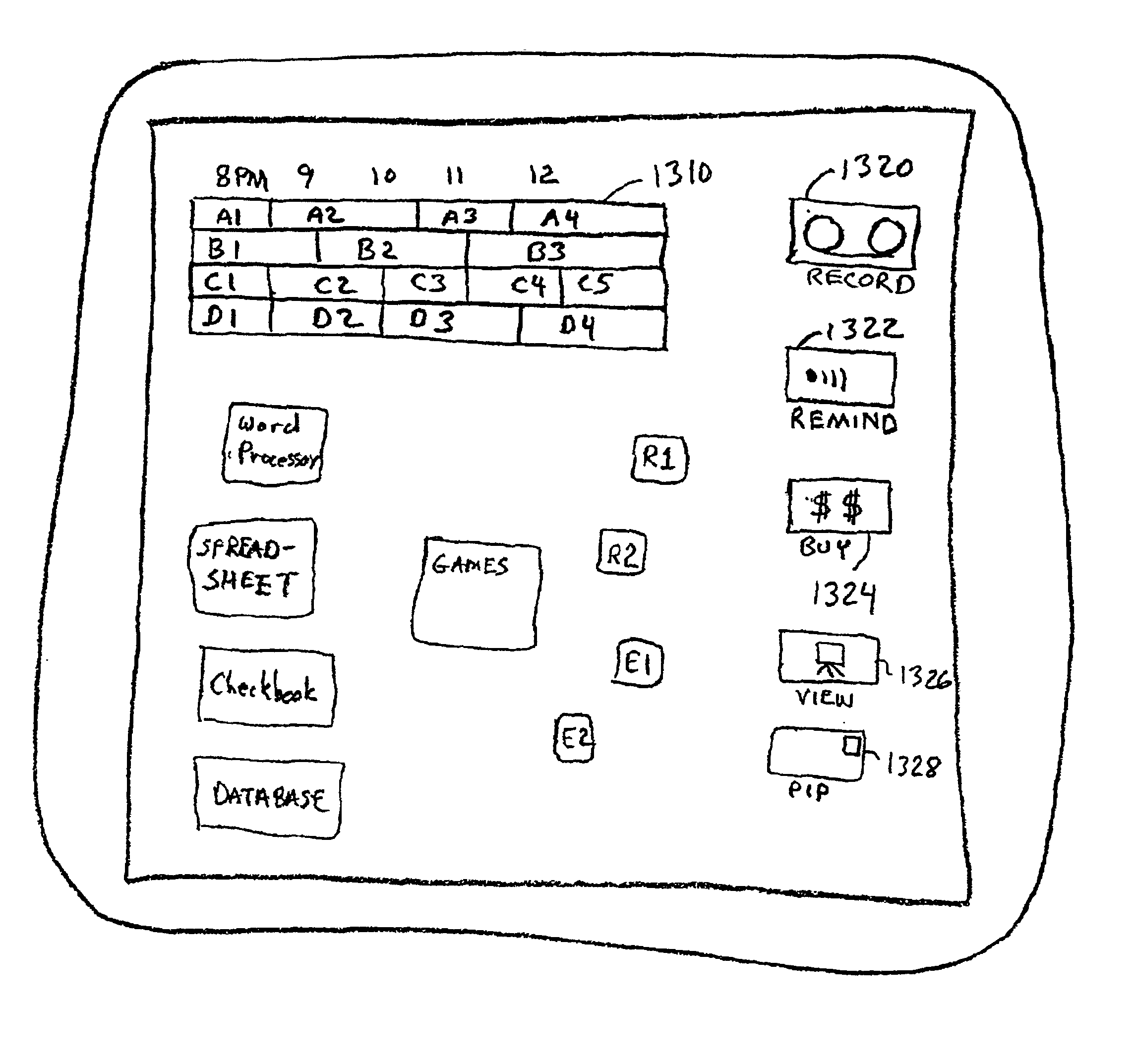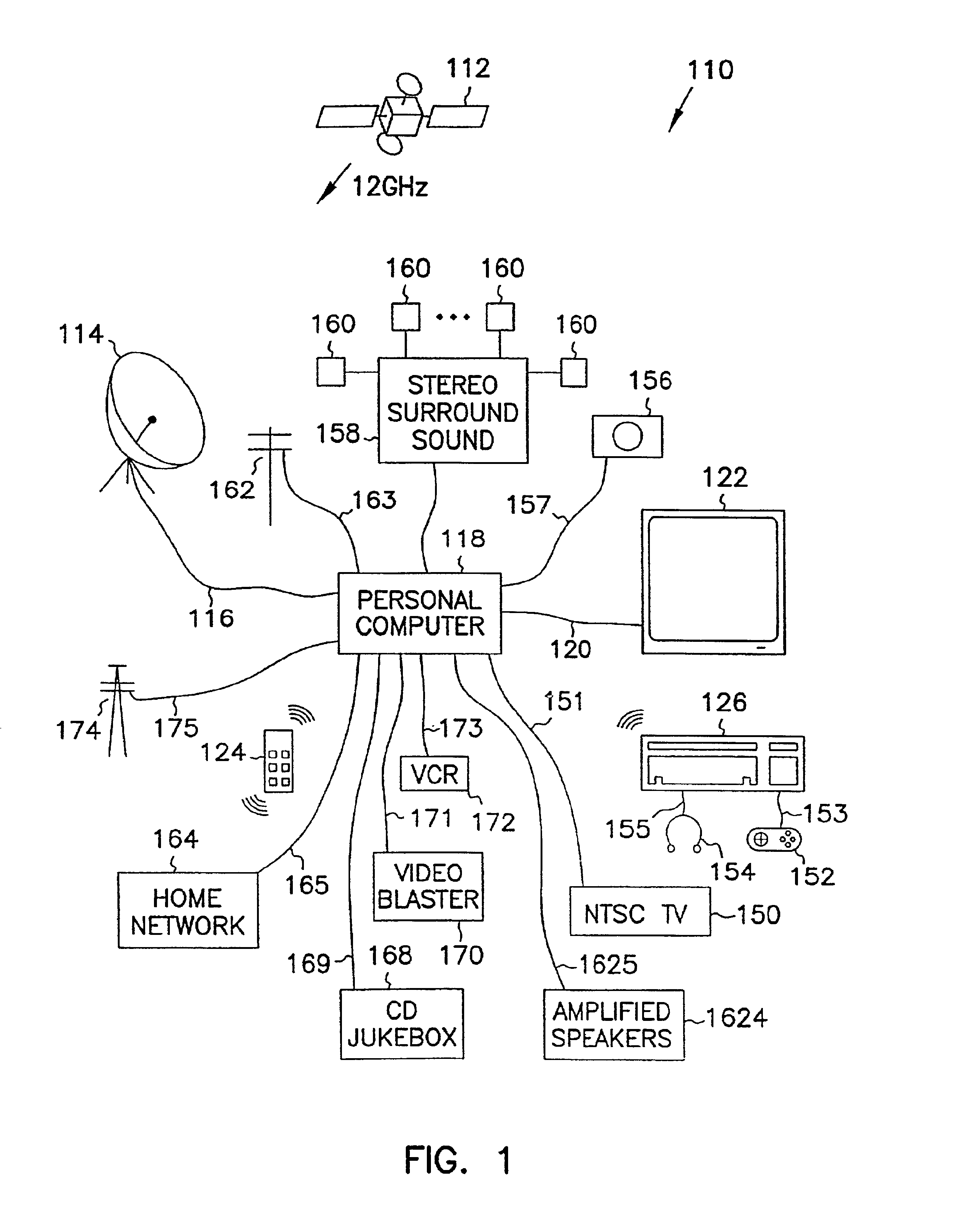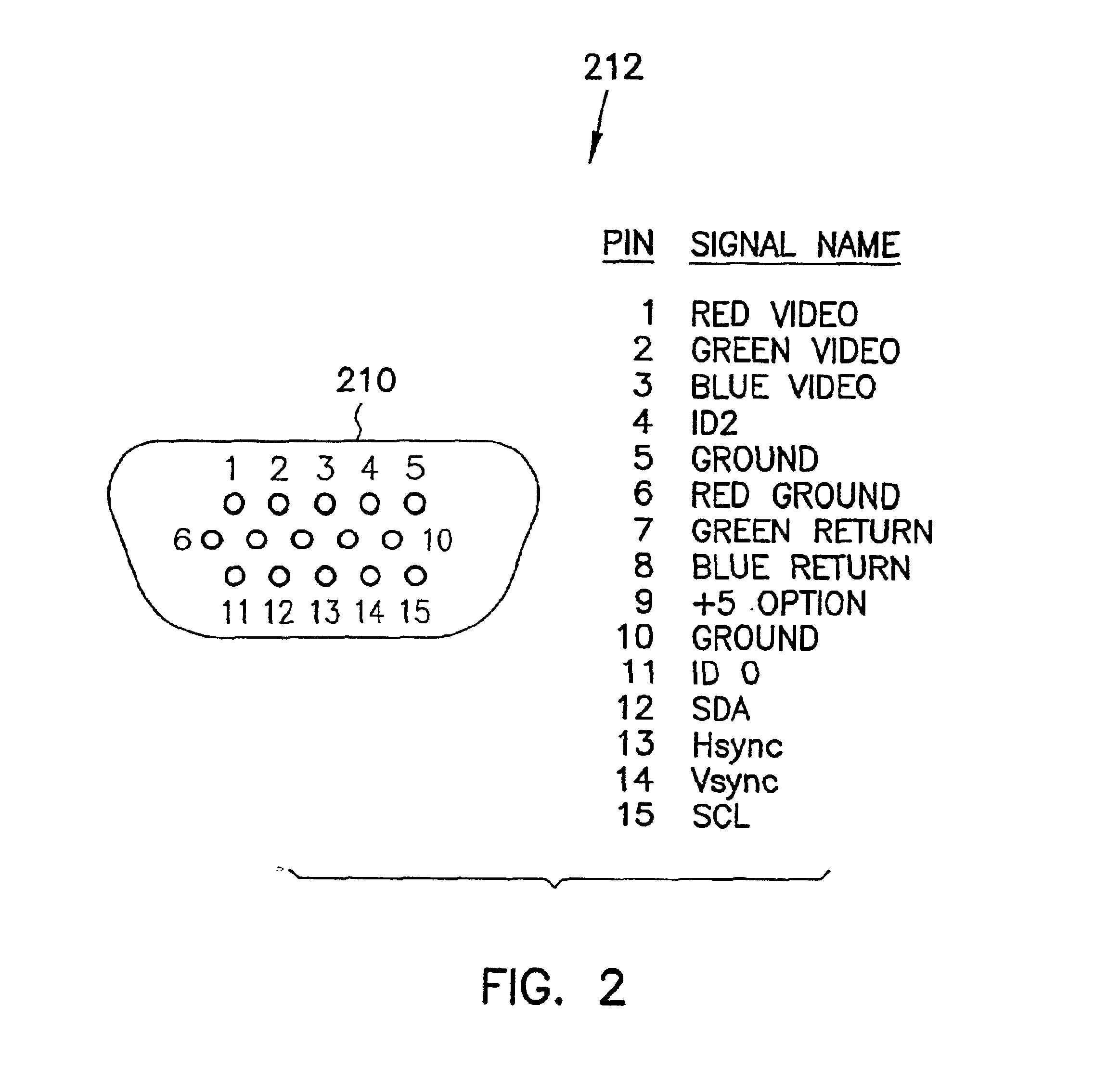[0012]A multipurpose computer system is provided with circuitry to control consumer
electronics, such as a large monitor or television for group interaction and of text,
graphics and video in a home entertainment environment The circuitry provides audio and video tuning capability for display of received high quality video signals on the monitor without an intermediate conversion to a lower quality
NTSC format. The circuitry
decodes the received video signals and converts them to VGA format which provides images of higher quality than NTSC. The monitor is capable of directly displaying VGA signals, and is not required to have a television
tuner circuit, remote control, or audio circuitry. This significantly reduces the cost of the monitor and improves the quality of display as opposed to typical
large screen televisions which contain complex tuning circuitry.
[0014]The video
receiver card outputs
digital video, audio and data streams onto the
peripheral component interconnect “PCI”
bus where it can be accessed by the computer main processor for manipulation and storage. When stored in a
personal computer memory, the program information may be organized in a commercially available
database format. This permits the use of
database functions to be applied to the data. Rather than being stuck viewing the program information as provided by the broadcaster, the data immediately becomes manipulable by database commands, allowing queries of program information. Searches are used to show programs having certain actors or
subject matter, and even have programs meeting the query automatically recorded. One use entails a user designating a series to be recorded, and the database keeps track of what has been recorded or already viewed, avoiding duplicate recording, as well as providing easy access to the recorded programs. In general, by capturing data along with video and audio in a form which a personal computer can process, the possibilities for computer applications are endless. Interaction with movies, classrooms, other players of games such as golf and a host of other possibilities becomes clear.
[0017]A video
graphics adapter (VGA) card also coupled to the PCI
bus converts the
digital data stream into VGA and video signals for display on the monitor. In addition to being a home entertainment system, a fully functional computer system forms the heart of the entertainment system. Instead of buying all the individual consumer
electronics parts, such as a
large screen television, settop box for receiving
broadband video, audio
amplifier / receiver,
CD player, universal remote control,
video game machine,
answering machine and fax, and a personal computer as some consumers do today, they need only buy the home entertainment system of the present invention. The cost is about the same as that for the individual traditional consumer electronics parts, making the personal computer essentially free.
[0018]Support for remote control of both the personal computer and the monitor functions is also provided in the personal computer as well as standard PC VGA graphic display functions normally associated with personal computers. Additional functions also become available based on the integration of devices and digitized data, video and audio. In this manner, no audio, remote control or channel tuning electronics is required in the display, which results in a much lower price for a large monitor suitable for home entertainment. Both a handheld remote control having standard television and in one embodiment, video
cassette recorder controls, and a full function remote keyboard having similar standard television and video
cassette recorder controls are provided. Both transmit key signals identifying the key pressed, as well as a
signal identifying the source of the key
signal. The key signals are preferably RF signals typically in the megahertz range, but can also be IR or other suitable form of
radiation. RF signals have the
advantage over
infrared “IR” signals in that they are not interrupted by someone walking between the remote and the receiver.
Light source interference and jamming of other IR receivers is minimized by using RF signals. It may also be used in a different room from the receiver.
[0019]The personal computer contains suitable receiving circuitry, which provides indications of the keys being pressed, with the identity of the remote control device sending the signal. In one embodiment, an
industry standard architecture (ISA) board or module is plugged into both the keyboard and mouse ports. Another
bus, such as a serial, RS232 or microchannel bus may also be used. The board contains RF receiver circuitry which receives the RF signals,
decodes them and routes them to the appropriate port for
processing. A receiving module is programmed to distinguish between the sources of the remote control transmitted signals, and directs keystrokes to the keyboard port, and mouse movements to the mouse port. The signals at the two ports then control which program the remote key signals affect. If the handheld remote is activated, the key signals usually would control what channel is being displayed, or cause a recorded program to fast forward, play or reverse. It could however be selected to move to the next image or otherwise control a program designed to display pictures taken on a
digital camera. Keyboard keys are more likely to control a
computer program application such as a word processor,
spread sheet or
electronic mail program. In one embodiment, the television like controls are used to override the remote
hand held television controls in channel selection. Just as easily, the
hand held remote controls
paging through
electronic mail. Additionally, the
hand held remote has a
pointing device, such as a trackball, or miniature
joystick with normally associated keys for selecting functions identified by the cursor on the display being moved by the
pointing device. The keyboard contains an integrated
touchpad for performing similar function, and additionally for transmitting signatures, providing the ability to ensure that an authorized user is requesting a transaction. Given the entertainment room environment, a
touchpad provides the further benefit of being able to withstand greasy popcorn and chicken fingers which might foul other pointing devices. In a further embodiment, each remote control device has its own unique cursor associated with it. In this manner, it is easier for the user of a particular device to know which program will be affected when the remote is used.
[0022]In a further preferred embodiment, the remote control devices are equipped with a user mechanism to reduce the power of the transmitted
radio frequency signals depending on their distance from the computer. Circuitry is provided to detect the
power level of the signal received and provide an indication on the computer screen, or transmit
power level signals back to the remote control device indicative of the
power level of the signal received. The remote control device has means to adjust the power, either by the user varying the resistance of the power
amplifier, or by digital adjustment of the power
amplifier based on the power level signals transmitted from the computer. The ability to control the power level of the signals helps lengthen the time required between replacing batteries which power the remotes.
 Login to View More
Login to View More  Login to View More
Login to View More 


